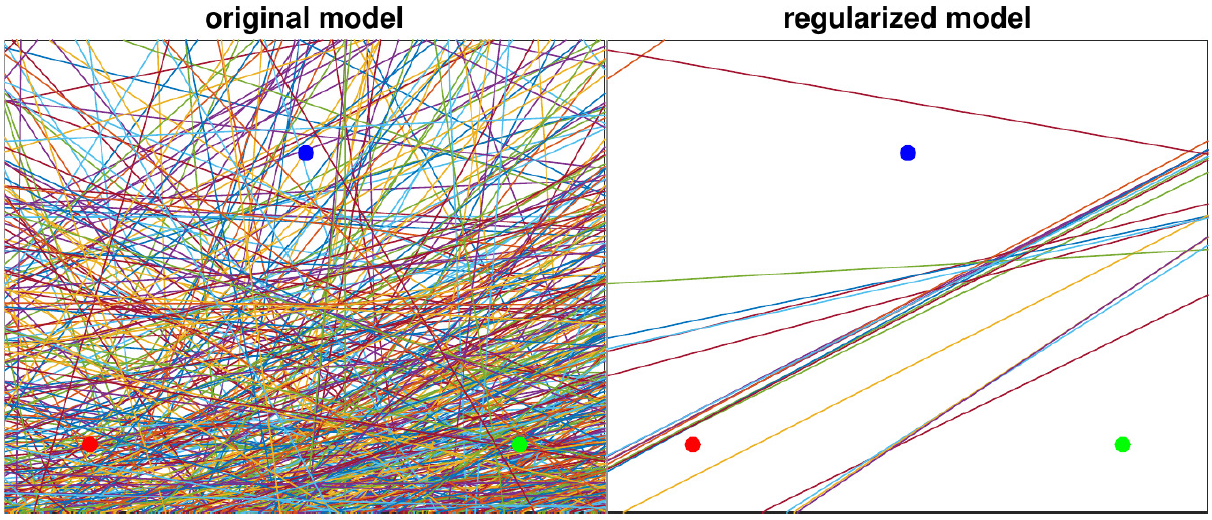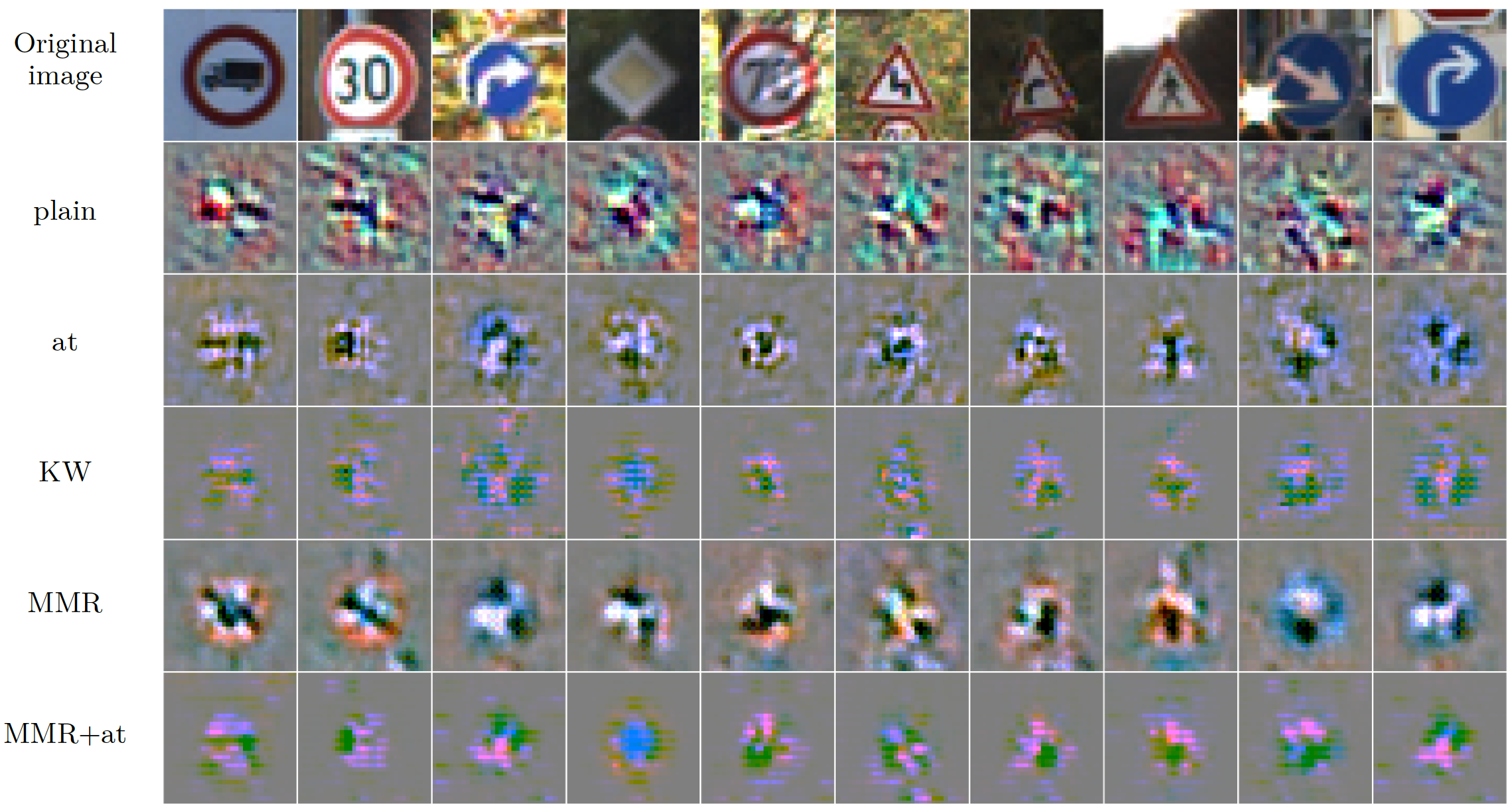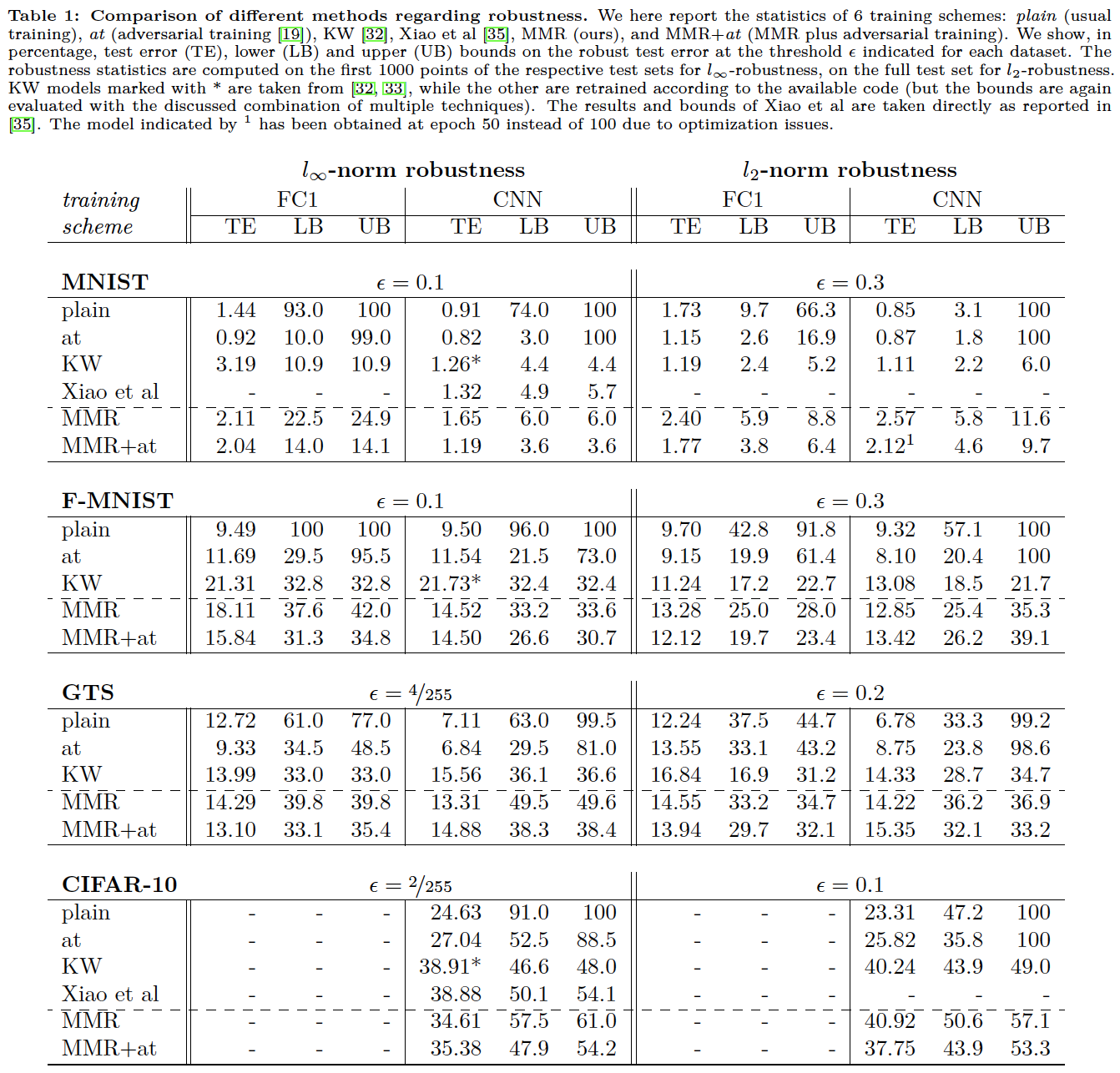AISTATS 2019
Francesco Croce*, Maksym Andriushchenko*, Matthias Hein
University of Tübingen and Saarland University
We introduce the Maximum Margin Regularizer (MMR), which expands the linear regions of ReLU-networks and pushes the decision boundaries away from data points:
Training with MMR leads to models which are provably robust according to the current state-of-the-art certification methods based on Mixed Integer Programming or its LP-relaxations.
To illustrate the effect of MMR, we show the linear regions of a ReLU-network on a 2D
subspace spanned by three random points from different classes
of MNIST. We observe a clear maximization of the
linear regions for the MMR-regularized case (right) versus the
non-regularized case (left). This is exactly what helps the certification
(for details, see the paper).

Inspired by the observation of Tsipras et al, 2019,
we also illustrate how the gradient of the loss wrt inputs is affected by MMR. We see that
it highlights more semantically meaningful features (i.e. the traffic sign, and not the background).
Therefore, it's not only a consequence of adversarial training, but potentially of all methods
that truly increase robustness of classifiers.

We also find that provably robust models wrt Linf-norm (our MMR and
KW training) lead
to very sparse convolutional filters.
Note that adversarial training of Madry et al, 2018 does not
have the same level of sparsity.
Below are the filters from the 1st and 2nd layers:

We present our extensive experimental results in the following table:
You can find all the models presented in this table in the folder models.
The subfolders correspond to the training scheme (plain, adversarial training, Kolter and Wong,
MMR, MMR with adversarial training):
plain, at, kw, mmr, mmr+at.
The file names of the models contain the hyperparameters used for their training. For example:
2019-02-17 01:54:16 dataset=mnist nn_type=cnn_lenet_small p_norm=inf lmbd=0.5 gamma_rb=0.2 gamma_db=0.2 ae_frac=0.5 epoch=100.mat
means that the model was trained on MNIST, the architecture was cnn_lenet_small (see models.LeNetSmall for its definition),
the MMR was applied wrt the Linf-norm with λ=0.5, γ_B=γ_D=0.2, with 50% of adversarial examples in every batch, and for 100 epochs in total.
The datasets used (MNIST, FMNIST, GTS, CIFAR-10) are provided also as .mat files in
the folder datasets.
Here are a few examples on how to train:
-
CNN model with Linf-MMR on MNIST with adversarial training:
python train.py --dataset=mnist --gpus 0 --lmbd=0.5 --gamma_rb=0.2 --gamma_db=0.2 --p=inf --nn_type=cnn_lenet_small --gpu_memory=0.5 --ae_frac=0.5 --exp_name=cnn_linf -
Fully-connected model with Linf-MMR on FMNIST with adversarial training:
python train.py --dataset=fmnist --gpus 0 --lmbd=1.0 --gamma_rb=0.15 --gamma_db=0.15 --p=inf --nn_type=fc1 --gpu_memory=0.3 --ae_frac=0.5 --exp_name=fc1_linf
More details are available by python train.py --helpfull.
Note that the implementation of MMR as a TensorFlow computational graph can be found in regularizers.py.
eval.py combines multiple methods to calculate empirical and provable robust error
(as we report in Table 1):
-
For example, to evaluate the MMR+at CNN model on MNIST wrt Linf norm on 100 test examples (expected running time: 6 min):
python eval.py --n_test_eval=100 --p=inf --dataset=mnist --nn_type=cnn_lenet_small --model_path="models/mmr+at/2019-02-17 01:54:16 dataset=mnist nn_type=cnn_lenet_small p_norm=inf lmbd=0.5 gamma_rb=0.2 gamma_db=0.2 ae_frac=0.5 epoch=100.mat" -
For example, to evaluate the MMR+at FC1 model on FMNIST wrt Linf norm on 100 test examples (expected running time: 9 min):
python eval.py --n_test_eval=100 --p=inf --dataset=fmnist --nn_type=fc1 --model_path="models/mmr+at/2019-02-25 15:20:35 dataset=fmnist nn_type=fc1 p_norm=inf lmbd=1.0 gamma_rb=0.15 gamma_db=0.15 ae_frac=0.5 lr=0.001 epoch=100.mat"
The two most important numbers are the combined empirical robust error pgd+mip lb: X% (PGD + MIP, i.e.
the lower bound on the worst-case robust error),
and the combined provable robust error kw+mip ub: Y% (Kolter-Wong + MIP, i.e. the upper bound).
Please note that for plain or at models, certification with MIPVerify.jl may take quite a long time.
So for testing purposes, we recommend to evaluate it on several points, e.g. with --n_test_eval=5.
More details are available by python eval.py --helpfull.
Note, that eval.py does not include evaluation of the lower bounds with
A randomized gradient-free attack on relu networks. GCPR, 2018,
which is available in a separate repository.
All main requirements are collected in the Dockerfile.
The only exception is MIPVerify.jl and Gurobi (free academic licenses are available).
For this, please use the
installation instructions
provided by the authors of MIPVerify.jl. But note that Gurobi with a free academic license cannot
be run from a docker container.
Also note that we use our own forks of kolter_wong (Wong et al, 2018) and
MIPVerify.jl (Tjeng et al, 2018) libraries.
And that in attacks.py we redefine the class MadryEtAl of Cleverhans library to support
normalized L2 updates for the PGD attack.
Please contact Maksym Andriushchenko regarding this code.
@article{croce2019provable,
title={Provable Robustness of ReLU networks via Maximization of Linear Regions},
author={Croce, Francesco and Andriushchenko, Maksym and Hein, Matthias},
journal={AISTATS 2019},
year={2019}
}

